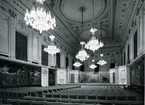Groser Redoutensaal
Giovanni Battista Carlone
Hofburg | |
| ukaž na mapě | http://www.hofburg.com/ |
významné události
lidé
historie
Giovanni Batista Carione constructed this room, called Newe Saal oder Danz Plaz zu Hoff, along with a smaller hall in 1629-30. It was renovated several times (e.g. by Francesco Galli Bibiena in 1698) and after 1720 was called Grosses Hoftheater. The large hall (51.3 x 19m.) was used for opera performances until 1744. In 1747 Antonio Calli-Bibiena converted it into a ballroom (called the Redoutensaal). The large room (now called Grosser Redoutensaat) seats about 1500 (with a reverberation of 1.4 seconds). Until 1870 this was the largest concert hall in Vienna. The small room (now called Kleiner Redoutensaal) seats about 400.
In: Harer, Ingeborg (1995) "Musical Venues in Vienna, Seventeenth Century to the Present,"Performance Practice Review: Vol. 8: No. 1, Article 8.
Autor: Ingeborg Harer
Ingeborg Harer:
Dodatečné informace
Žádné informace nebyly zatím vloženy
přidej data








